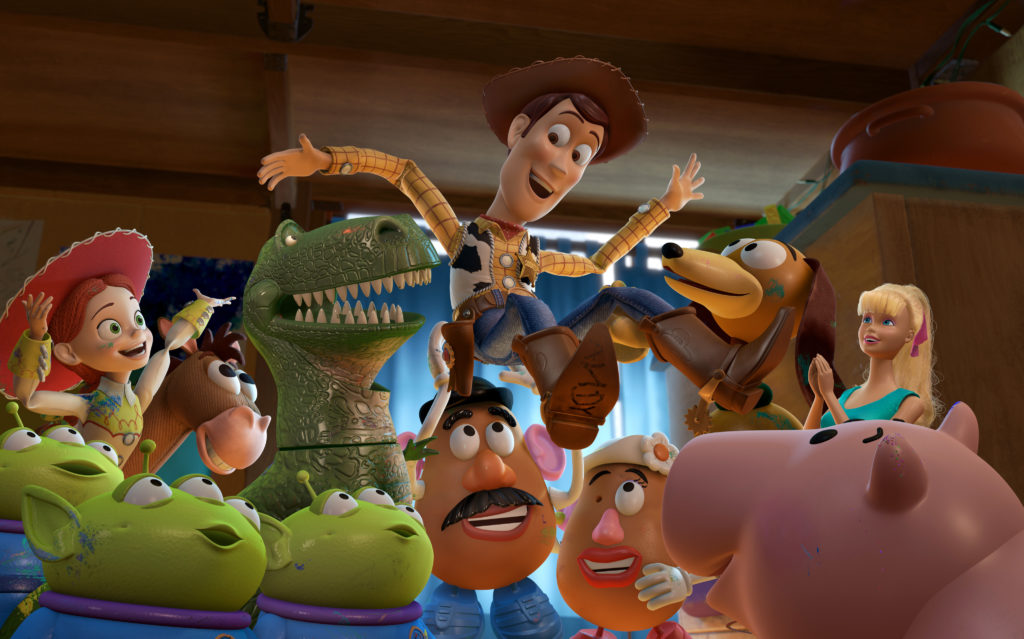
It’s been a while since we last saw them—11 years, to be exact—but Woody, Buzz Lightyear and their makeshift family of beloved toys are still happily residing in Andy’s toy box. It’s a somewhat forgotten abode nowadays, but it’s theirs. And even if Andy has paid them little heed of late, well, they can always live on the memories of yesteryear’s glorious playtimes.
Occasionally they might even grab Andy’s cell phone, luring him in to remind him of all the fun that could be his once more if he would just play with them like he used to. Alas, however, 17-year-olds like Andy aren’t often in the playing mood. Not with old toys, anyway.
“Every toy goes through this,” Woody reassures his worrying pals. Secretly, however, even Woody senses the significance of their owner getting older. And as the toys peek through the lid of their boxy home, they learn that Andy will soon leave for someplace called “college.” Gasp! What will happen to them? Will they be sent to the attic? Or worse?
Through a series of mishaps that follows, the gang eventually ends up being donated to the Sunnyside Daycare Center. At first, it seems like a toy’s paradise—a place where it’s playtime all the time. Barbie even meets a hunka hunka plastic love called Ken. This perfectly coiffed guy loves trying on new outfits even more than she does.
But there’s also a less-than-pleasant side to this kid-filled playground. Newcomers get sent to the Caterpillar Room, where toddlers beat the stuffing out of their toys. Not only that, but the whole place is under the controlling eye of a strawberry-smelling leader named Lots-o’-Huggin’ Bear (or, Lots-o’ for short) who rules with a pink, furry, Machiavellian fist.
Woody, however, doesn’t stick around long enough to learn about Sunnyside’s dark side. No matter what, he says, he must make his way back to Andy—even if everyone else is convinced that their beloved owner no longer wants them.
When he learns that his friends back at Sunnyside are in trouble, though, Woody has a decision to make about where his deepest loyalties lie.
Woody and pals must learn to cope with a sense of abandonment as Andy seems to turn his back on them. And that painful chord of loss resonates throughout the story. Woody, however, holds tightly to his faith in Andy and tells the toys, “Andy’s gonna take care of us. I guarantee it.”
But one thing’s for sure, regardless of Andy’s choices: The toys refuse to abandon each other. The whole community of friends voices its commitment to fight for one another and stick together—whether that means the attic or the junk heap. “What’s important is that we stay together,” Buzz says. And he, Woody and the rest always live by that credo. Late in the movie, when it looks as though they could end up in a place far worse than the city dump, the toys reach out to join hands and face their desperate situation in unity.
The toys also put themselves at risk to save others. For instance, Buzz tosses Jessie to safety at one point, knowing that he’ll receive a bruising blow from a falling TV. Elsewhere, Woody and Buzz strive to save a villainous character even though that toy pulled them into danger in the first place.
The movie also makes a subtle, but positive, statement about commitment. When our toy heroes first go to the day-care center, they’re told by Lots-o’ that “no owners means no heartbreak.” (Lots-o’ once had his stuffed teddy bear heart broken by a little girl who replaced him when he was left behind at a picnic.) But Woody reaps the rewards of standing committed to his teen owner. And in the end, even though situations do change, Andy shows himself to be a caring and devoted pal to his toy friends.
The subject of death is never dealt with in so many words, but as the toys wrestle with endings of various kinds, it’s almost impossible for viewers not to grapple with the reality of death and loss at some level.
Andy and his mom are feeling the pangs of loss over their upcoming separation, too. They embrace and voice their love for each other.
A little girl playing with her toys mentions ghosts a few times.
It’s no surprise that Ken and Barbie feel an instant attraction for each other. After all, they gush, it’s like they were made for each other. “Love your leg warmers,” Ken compliments. “Nice ascot,” Barbie retorts. They’ve barely met when Ken asks if Barbie wants to come live in his dream house. She seems to accept, if only for a day or so. Over the course of their romance, the couple holds hands, rubs noses and tells each other “I love you.”
Later on, after things go bad between the pair because Ken is working for Lots-o’, Barbie, who is prone to wearing slinky outfits, ties him up after, apparently, removing his shirt and pants. We see him wearing nothing but polka dotted boxer shorts, which is his attire for much of the rest of the film. As she’s tying him up, he suggestively says, “You can’t make me talk. You can’t! But I’d like to see you try.”
Ken’s sexual orientation, if a doll can have such a thing, is never in question. That said, the film makes a couple of wink-wink references to effeminate stereotypes when it comes to Ken’s obsession with clothes and his appearance. Fellow toys roll their eyes when talking about Ken’s wardrobe and his perfect, flowery penmanship. Ken insists, “I’m not a girl’s toy. I’m not!” When Barbie disguises herself in one of Ken’s outfits, she forgets to take off her high heels, prompting a smirk from another toy.
An innocent romantic relationship also blossoms between Buzz and cowgirl Jessie. That attraction intensifies when Buzz’s computer processor is accidentally switched to Spanish. Suddenly the spaceman takes on the characteristics of the stereotypical hot-blooded Spaniard—including flamenco dancing, impassioned glances and heartfelt expressions of affection. Jessie likes the attention and later flips on some Latin music just to rekindle the flame with a quick dance.
The movie opens with Andy directing the toys in an imaginary Western story that features Woody and the gang as characters fighting a melodramatic battle between good and evil. Rough and tumble action and explosions ensue, but no one is hurt. And that standard is mostly maintained throughout the rest of the film.
There are a couple of intense scenes where it looks like a character could be hurt, though. The toys, for example, make their way through an ominous garbage-recycling plant complete with whirling blades and a blazing furnace that threatens to incinerate them.
Lots-o’s thug toys grab and imprison our toy heroes. And we see a Chatter Telephone who looks a little beat up after an encounter with those same bully toys. But that implied torture doesn’t take place onscreen. In fact, the toys take their worst pounding at the hands of a classroom full of toddlers who seem trample and tramautize every toy they touch.
Other moments of cartoon violence include Woody jumping on a monkey guard and wrestling him to the ground. (He shoves the monkey into a drawer and leave him there, all tied up with tape.) He also falls hard from a hang glider into a tree. A garbage truck driver finds Lots-o’ and ties him to the grill of his truck. (To the driver, the bear is just a silly hood ornament. To the toy, it’s a brutal punishment for wrongs done.) A truck runs over the Martian triplets, but they show up later, unscathed. For a moment, it looks as if toys have been crushed in a garbage truck trash compactor.
As is often the case in Pixar’s films, certain moments pay homage to classic movie scenes and genres, references adults may recognize that will sail over the heads of young viewers. And that’s the case here, too. The toys’ imprisonment is a nod to many prison-escape stories. Mr. Potato Head’s solitary confinement in “The Box” seems like a reference to Vietnam films. And when a baby doll’s head spins around to spy escaping toys, it feels like something out of a horror movie.
Twice we hear “what the heck?” Another time that phrase gets cut short. A character says, “Darn it, Barbie!” Ascot and astronaut are both used to subtly bring to mind a crudity. Name-calling includes “drooling doofus,” “idiot,” “imbecile,” “pea-brain” and “moron.” “Holy moly” and “holy cow” pop up.
None.
When the thug toys lock Mr. Potato Head in the sandbox overnight, he comes back to report, “It was cold and dark. Nothing but sand and a couple Lincoln Logs.” Hamm retorts, “I don’t think those were Lincoln Logs!” During the credits, Mr. Potato Head shoos some little toys out of his back hatch shouting, “I told you kids. Stay out of my butt!”
Buzz comes upon a group of toys gambling with Monopoly money in a secret location that has the feel of a speakeasy.
Woody and the gang kicked off the whole full-length computer-animated film craze 15 years ago. And they took everyone by surprise. Entertainment Weekly recently labeled Toy Story (Pixar’s first film) the “popgun shot heard ’round the world.” And when you add in Toy Story 2‘s success and Pixar’s blockbuster track record since, well, there’s a lot to live up to when making a second sequel.
But in spite of the fact that today’s kids are more apt to play with virtual avatars than plastic action figures, this third tale about toys with a secret life of their own is still just as charming and appealing as ever.
This latest outing joyfully reunites us with Woody, Buzz, cowgirl Jessie and their friends. And it expands the toys’ ranks with several other entertaining newcomers, such as Mr. Pricklepants, an English thespian hedgehog; and Big Baby, a mostly mute, oversized enforcer who feels like a character from Of Mice and Men.
All in all, this is just like the first two installments in the franchise, only bigger.
That’s the nature of a sequel, though, isn’t it? Make things bigger. Bigger cast, bigger laughs, bigger booms. Toy Story 3 doesn’t shy away from the challenge. It’s packed with inventive gags and knowing pop-culture references (including a few questionable ones at the expense of Ken’s masculinity). As for the action, it’s epic in ways 1 and 2 never were. The adventure careens from rollicking rescue to a strategic jailhouse breakout to a musketeers-like last stand.
In fact, some of that action intensity—including an extended life-or-death moment in which it looks as if everyone is about to perish—could be a little too intense for the youngest viewers, those whom you might be inclined to think would be the film’s most natural audience.
But this is far more Up than Horton Hears a Who! And as is the case with Up, Pixar’s version of bigger works best when that large lump starts forming in your throat near the end. It’s amazing, really, that a CGI-created pull-string cowboy can come to embody loyalty, bravery and love.
But he does. And somehow just waving good-bye to a group of well-worn toys can powerfully communicate the emotion of both a teen bidding childhood farewell and a parent watching him take the next bittersweet step in his journey.


After spending more than two decades touring, directing, writing and producing for Christian theater and radio (most recently for Adventures in Odyssey, which he still contributes to), Bob joined the Plugged In staff to help us focus more heavily on video games. He is also one of our primary movie reviewers.
Our weekly newsletter will keep you in the loop on the biggest things happening in entertainment and technology. Sign up today, and we’ll send you a chapter from the new Plugged In book, Becoming a Screen-Savvy Family, that focuses on how to implement a “screentime reset” in your family!